
Theme 4: Informed Decisions
The purpose of data collection and modelling is to learn more about the complex systems that characterise the world we live in, and make the best possible decisions about their operation. Under this theme we develop new decision-making methodologies, and exploit the outcomes from the Challenging Data, Multiscale Models, and Enabling Algorithms themes to make decisions that benefit society, by characterising optimal decision-making strategies over a range of timescales. We work closely with our Partner and Affiliate Organisations to translate the outcomes of this theme into real world outcomes with impact.
The Numbers
Researchers
Cross-node collaboration Groups
Industry Partners and Projects
People
Key Achievements
In 2020, ACEMS researchers developed a wide range of targeted research outputs and outcomes to solve important problems in the three domains of Healthy People, Sustainable Environments and Prosperous Societies. Some of these achievements are described below.
General Theory:
Research Fellow Mehdi Foumani has been working under supervision of CI Kate Smith-Miles to improve decision making tools for real-world systems. The focus has been on three types of manufacturing and service operations: energy systems, robotic systems, and e-commerce. For energy systems, the ACEMS team have continued working on mathematical models to help government determine optimal policies to drive behaviour change, exploring how the parameters of various schemes (e.g. carbon emission trading schemes, taxes on emissions) can be chosen to help manufacturers reduce carbon emissions while remaining economically competitive in a global market. For robotic systems, the ACEMS team has provided an integrated framework for designing robotic systems with different levels of quality including low (e.g., disassembly industries), medium (e.g., automotive industries), and high (e.g., aerospace industries). Finally, considering environment-friendly methods, they have optimised modern drone-assisted logistics systems to improve order fulfilment processes of e-commerce companies. This has included the order life cycle from the moment a customer places the order to the moment the customer receives the products.
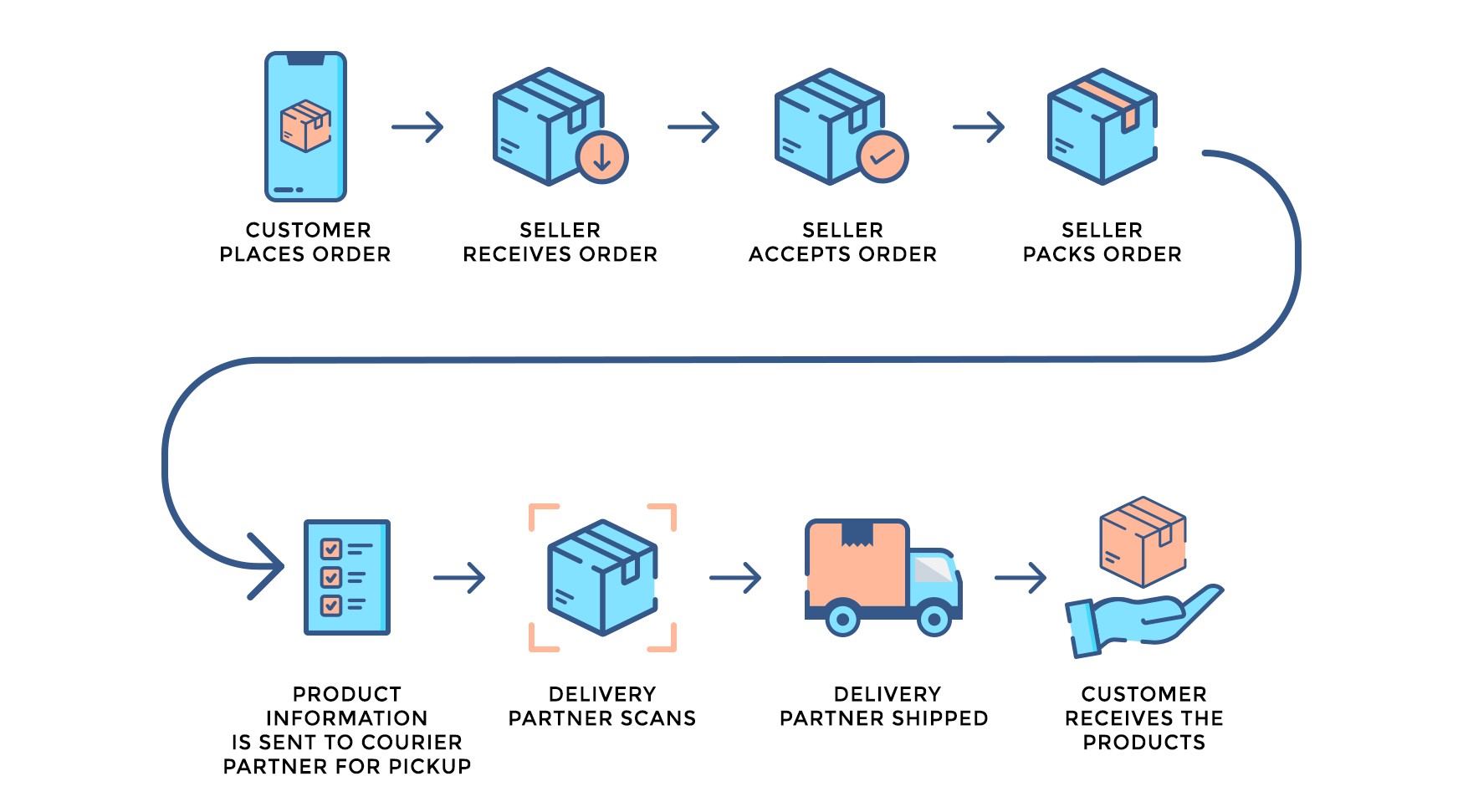
The order life cycle for when a customer orders a product, right up till the delivery to the customer.
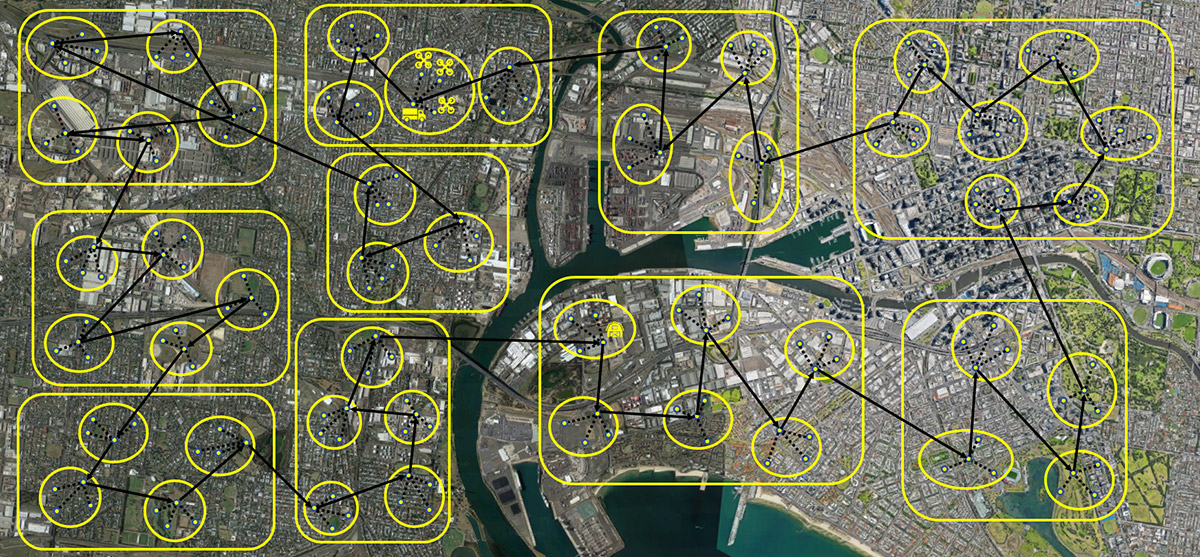
An example of a CGTSP route for a drone-assisted PDS in Melbourne central business district

The relationship between emissions and speed for a truck with 13000lb gross weight
AI Alysson Costa gave a plenary talk at the 52nd Brazilian Symposium on Operations Research (SBPO). Benders reformulation projects a model into a subset of its variables, creating a problem with an exponentially large number of constraints. Benders decomposition relaxes this large model and iteratively generates the constraints until a proven optimal solution is found. In his talk, Alysson presented an overview of the Benders technique, highlighting the basic theory behind the reformulation, ideas for an efficient implementation of the decomposition and recent advances on the method. The video of the talk has received over 800 views.
Healthy People:
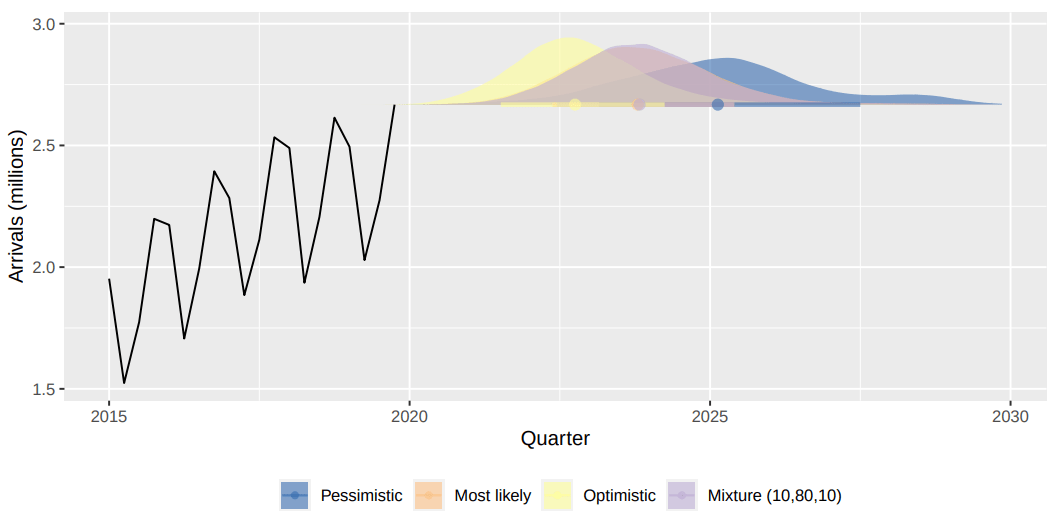
Shows estimated time of recovery for international tourism in Australia.
Research Fellow James Walker prepared scenario modelling reports for the Australian Health Protection Principal Committee (AHPPC, the key decision making committee for health emergencies) which informed the Commonwealth Government's early COVID-19 pandemic response. Thereafter he continued to report to AHPPC with analyses of household transmission study data which provided updates on the transmission dynamics of COVID-19 in Australian households.
CI Rob Hyndman also contributed to the pandemic effort. He developed weekly ensemble forecasts for COVID-19 cases in Australia, which were used by the national and state governments for policy planning. This was cross-nodal collaboration with the University of Adelaide. Rob also developed forecasts for Australian tourism over the next few years, taking account of the COVID-19 disruption.
Nicole White, a Research Fellow with the Australian Centre for Health Services Innovation at QUT and an ACEMS AI, was awarded an Advance Queensland Industry Research Fellowship to contribute towards COVID-19 research. This award is recognition of Nicole’s engagement with external partners and her commitment to using her statistical skills to help address challenging real-world problems. Nicole was also selected as part of the new Superstars of STEM cohort commencing in 2021. Superstars of STEM is an initiative of Science and Technology Australia that aims to increase the public profiles of women in STEM and STEM careers.
In Australia, blood donations are collected by Australian Red Cross Lifeblood from almost entirely non-remunerated voluntary donors. Therefore, it is important that Lifeblood provides a satisfying service that ensures donors complete the donation process, but also to return regularly to donate blood. Long assessment and waiting times adversely affect the donor experience and consequently the donor return rate. One key performance indicator for donor centres is Time-to-Couch (TTC), that is, the time from the donor's arrival to the commencement of their donation. TTC is a combination of the registration and assessment durations, and the times donors need to wait to be registered, assessed, and commence donation. These waiting times can be reduced by making the donor flow more efficient. To better streamline the donor flow, staff shift scheduling and resource allocation is crucial. PhD student Achini Erandi has led the development of a simulation model to capture the uncertainty in the donation process, and then developed a method for determining optimal staff schedule and resource allocation based on the predicted demand.
Demand for emergency department (ED) care has increased rapidly over recent years in Australian public hospitals, with resultant ED overcrowding and longer waiting times for patients. Due to lengthy queues, some patients leave the ED without being seen by a doctor while others leave with partially completed care, both contributing to higher re-presentation rates and poor system performance. PhD student Kalpani Ishara Duwalage has been leading research that primarily aims to identify demographic, clinical and time-varying factors/subgroups associated with the quantity of ED presentations. This research also aims to develop statistical and machine learning models to forecast ED presentations for short-term and long-term periods using the factors identified previously. In a fiscally constrained environment, it is essential to optimally organise the available resources to increase the efficiency, and therefore sustainability of current health systems.
CI Louise Ryan is part of a project funded by the US National Institutes of Health looking at the effects of pre-natal exposure to alcohol on child development. While it is well known that high levels of alcohol exposure in pregnancy have serious adverse effects, much less is known about low level exposures. Until recently foetal alcohol spectrum disorders have not been recognized as a diagnosable Disorder in the Diagnostic and Statistical Manual (DSM) of the American Psychiatric Association. However, in the latest revision of this manual, a new diagnosis ’Neuro-developmental Disorder Associated with Prenatal Alcohol Exposure' was Recognized for the first time as a ’condition in need of further study.’ One criterion for this provisional diagnosis is a history of more than minimal levels of prenatal alcohol exposure, which, in the absence of empirical data, has been deemed as 13 or more drinks/month during pregnancy. An important goal of her current NIH-funded study is to determine whether prenatal alcohol exposure at this level is reliably related to a clinically significant cognitive or behavioral impairment. The data come from six different birth cohorts where mothers were enrolled pre-natally and the children followed from birth into young adulthood. A variety of developmental tests were administered to the children at various ages. The resulting data are complex in that they are observational, multivariate and longitudinal. CI Ryan’s role in the project involves developing and evaluating suitable statistical methodology. The team is considering a variety of approaches including structural equations modelling and estimating equations approaches. Research Fellow KD Dang has been working on a Bayesian approach to fitting structural equations models in settings where there are multiple cohorts involved, each of which is measuring slightly different outcomes. This work was presented at the Virtual International Biometrics Conference in August and also at the ACEMS Virtual Retreat.
CIs Kevin Burrage and Kerrie Mengersen and AI Brodie Lawson collaborated with several international researchers to create a new method for very rapidly creating virtual populations calibrated to data. This tool is critical for better understanding the differential effects of drugs across variable populations, and for the better targeting of treatment decisions. In the area of cardiac electrophysiology, these virtual population approaches are already displacing animal testing. This work is a significant methodological extension of that published previously by many of the same ACEMS members in Science Advances in 2018. The technique will be submitted for publication in early 2021.
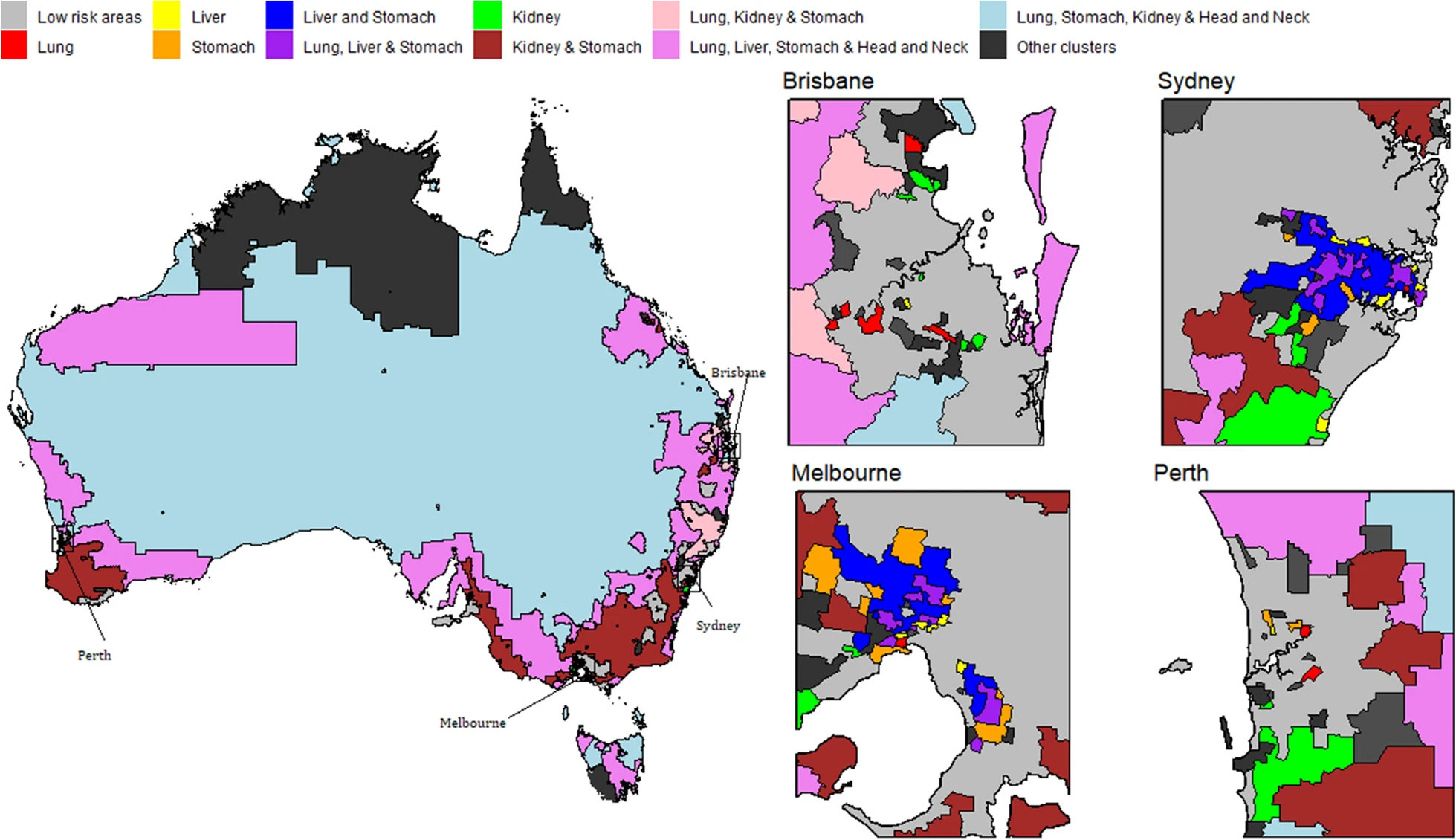
The high and low risk areas for smoking related cancers for males, developed in the multivariate meta-analysis paper by Jahan et al. 2020.
PhD student Farzana Jahan’s research was undertaken in collaboration with ACEMS Affiliate Partner, the Cancer Council Queensland. Her research involved the development of Bayesian meta-analysis models that can analyse online available disease data from spatial data bases for getting further insights about the underlying patterns of disease incidence, without having access to the individual level data. Getting access to individual level disease data is cumbersome due to confidentiality and administrative purposes, whereas, there are now some disease data bases or atlases that provide publicly available information on disease mortality, incidence or survival at small area level. This novel approach was applied to the Australian Cancer Atlas (ACA) to identify potential differences in incidence of various cancer types in major cities, regional and remote areas in Australia. The work was published in two Q1 journals and received media attention. Farzana’s co-author, ACEMS AI, Susanna Cramb was interviewed in ABC radio SEQ mornings about this work and Farzana also gave an interview in a Science related TV show in Iran International TV. The proposed meta-analysis models will help policy makers to make informed decisions by exploring newer and significant research questions, without waiting for the access to confidential individual level disease data. These methods potentially broaden the scope of cancer research and usability of spatial data bases in order to make informed decisions.
ACEMS has encouraged industry-led research training, with a number of collaborators undertaking postgraduate training. For example, Scott Jones, a practising radiation therapist is undertaking a PhD on the use of statistical machine learning models and health economic methods to improve rectal protocol compliance in prostate external beam radiation therapy. Scott is co-supervised by a cross-disciplinary team of ACEMS researchers at QUT and by Dr Cathy Hargrave, who is a radiation therapist at the same Hospital and who completed her workplace-embedded PhD with ACEMS a few years ago.
AI Susanna Cramb received a Queensland 2020 Young Tall Poppy Award! She was also a key part of the team that won two prestigious awards for the Australian Cancer Atlas: the Spatial Enablement Award, Oceania Asia-Pacific Spatial Excellence Awards, and the JK Barrie Award for Overall Excellence, Asia-Pacific Spatial Excellence Awards. Susanna was also awarded an ARC LP to further develop the Australian Cancer Atlas, and an NHMRC Ideas grant, led through University of Canberra, titled ‘Novel modelling to improve decision-making for neighbourhood design to reduce chronic disease risk’.
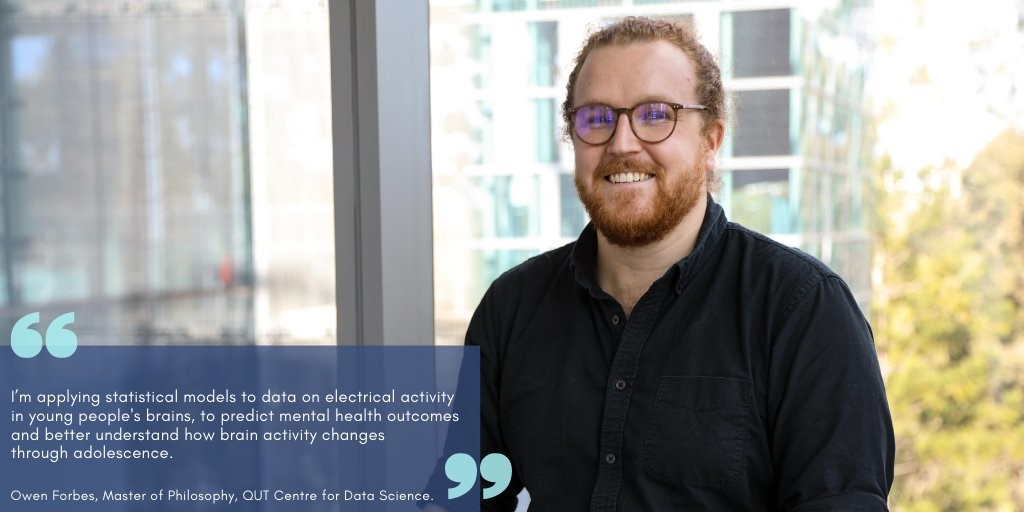
Sustainable Environments:
Large-scale carbon emission from soil (one of the major carbon reservoirs) into the atmosphere has many impacts on global climate change, soil quality, and crop productivity. On the other hand, soil organic carbon (SOC) is a significant global sink for atmospheric carbon through land-management practices which can help to reduce the atmospheric concentration of greenhouse gases and improve agricultural productivity. Changes in soil carbon stocks can be quantified using accurate models of soil carbon turnover and sequestration that help to have a deeper understanding of sequestration process and forecast future changes and trends in SOC. In addition, carbon accounting is now an important activity of governments throughout the world who have made commitments under the Kyoto Protocol and the Paris Agreement on Climate Change. PhD student Mohammad Javad Davoudabadi has written a paper on the online journal Environmental Modelling and Software where he described the improved efficiency and speed of computation in modelling soil carbon sequestration using advanced Bayesian methods. The paper has served as a tutorial paper for soil scientists and more general environmental scientists.

Predicted groundwater level response with ARIMA (top) and LSTM (bottom) models. The ARIMA prediction includes 80% and 95% confidence intervals. Both models include the 120 preceding days of rainfall and evapotranspiration measurements as lagged predictor variables. The mean squared errors for both predictions, compared with the observed water level timeseries, are 0.0004.
CI Louise Ryan has established a productive collaboration with the NSW Office of the Chief Scientist and Engineer, where her role is to advise on decision making under uncertainty. Her main project involved modelling of bore water levels in a river basin in Western NSW also involved CI Rob Hyndman and Research Fellow Stephanie Clark. The work, a continuation of what was done the previous year for the Richmond River basin, is more complex because western NSW is much drier and the river basins there are under significantly more stress due to low rainfall and extractions for irrigation and other purposes. In a paper published in the International Statistics Review, they explored the use of deep learning techniques as well as classical statistical modelling based on time series methods to model bore water levels measured in some cases over 40 years as a function of rain and other climate variables. Both approaches worked well for the aquifers in the wetter, north eastern part of NSW as shown in the following figure which shows observed and fitted values. However, when these same techniques were used for the river basin in the drier western NSW region, the results were not as good, mostly because there seem to be additional time trends present, most likely associated with extractions for irrigation, drinking water and other purposes. Also, it is not clear how accurately extractions are measured. The work is important since it lays the ground work for predicting aquifer levels into the future and hence providing valuable input to government agencies charged with decision making around water extraction licenses.
AI Kate Saunders helped contribute statistical expertise to the detection-attribution study of the Australian bushfires that was used in the Australian Senate Enquiry. Kate is an author on the forthcoming paper “Attribution of the Australian bushfire risk to anthropogenic climate change”, NHESS. Disastrous bushfires during the last months of 2019 and January 2020 affected Australia, raising the question to what extent the risk of these fires was exacerbated by anthropogenic climate change. The study reveals the complexity of the 2019/20 bushfire event, with some, but not all drivers showing an imprint of anthropogenic climate change.
Kate worked with a Master's student Jieyu Chen at Utrecht University and Senior Researcher, Kirien Whan at Koninklijk Nederlands Meteorologisch Instituut (KNMI) to perform quality control and bias correction of citizen science wind data (https://wow.metoffice.gov.uk/).

Applied Mathematical Ecology Group at QUT (co-led by Kate Helmstedt). Mathematicians working on environmental problems. From left: Jessica Hopf, Grace Heron (ACEMS), Helen Mayfield, Kanu Agarwal, Kate Helmstedt (ACEMS), Tace Clifford, Claudio Arancibia Ibarra, Cailan Jeynes Smith, Mike Bode (ACEMS), Ryan Heneghan.
The study “Forecasting intensifying disturbance effects on coral reefs” was published in the journal Global Change Biology. It is the result of a collaboration between ACEMS researchers at QUT and the ARC Centre of Excellence of Coral Reef Studies at UQ. They used statistical modelling to explore the effects of broad‐scale climate‐related disturbances on benthic communities to predict their structure under scenarios of increasing disturbance frequency. They provided a better understanding of the effects of multiple disturbances on benthic communities as a whole is essential for predicting the future status of coral reefs and managing them in the light of new environmental regimes.
AI Sevvandi Kandanaarachchi (with AI Mario Andres Munoz) has continued to pursue industry-relevant research in time series through work on early detection of vegetation ignition due to powerline faults, one of the main causes of wildfire. The results demonstrate that the proposed methodology allows the detection of ignition risk well before its onset with high accuracy. Sevvandi has also been part of numerous inter-node (QUT-Monash-UoM) research collaborations on the early classification of spatio-temporal events and on outlier detection. All projects have led to high-profile journal articles and the work on dimension reduction for outlier detection has also resulted in a new R package, DOBIN.
Prosperous Societies:
CI Rob Hyndman developed new methods for high-dimensional forecast reconciliation, identified drivers for voter behaviour in Australian federal elections, and developed new methods for exploring probability distributions disaggregated by calendar granularities. One of the ways the approach can be illustrated is using data from the sport cricket. Although there is no conventional time component in cricket, each ball can be thought to represent an ordering over the course of the game. Numerous questions can be addressed with the cricket data, for example, ‘does the distribution of total runs vary depending on if a team bats in the first or second innings?’
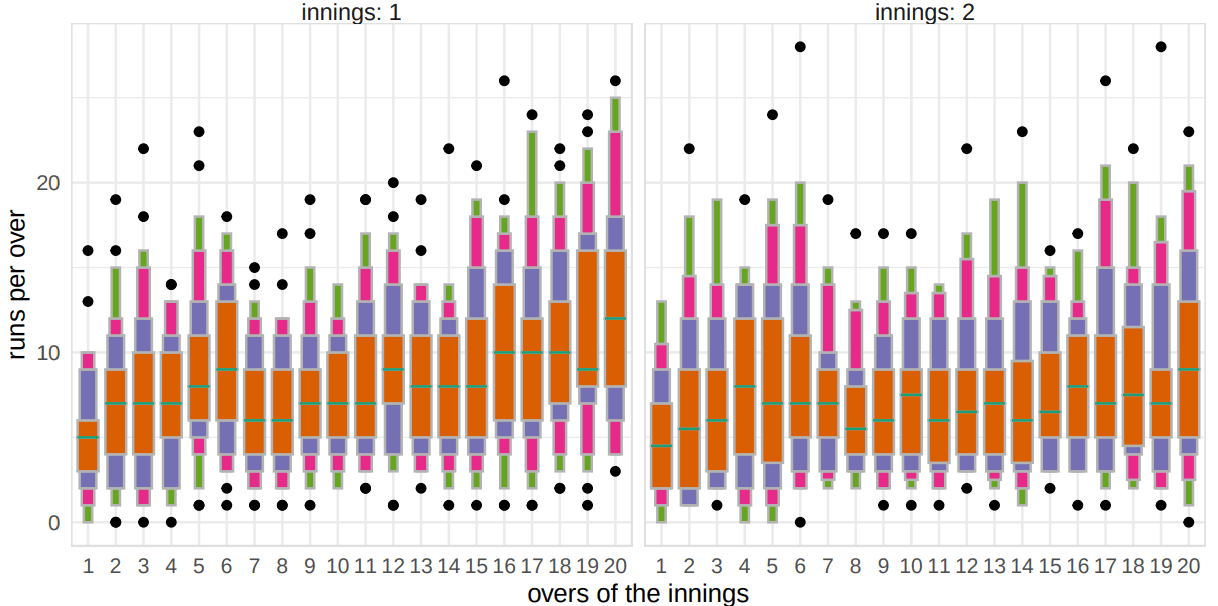
Runs per over in T20 IPL cricket matches showing that the team batting first accelerates over the innings whereas the team batting second does not.
Competitive Swimming Reimagined: using data to help get the win - feature from QUT LABS DOCUMENT (click to view)
AI Paul Wu, worked in collaboration with the Australian Institute of Sport and the West Coast Eagles on preliminary studies and pilot work to support the development of novel methods to support coaches, athletes and other decision makers in managing injury risk of athletes/players, especially with respect to training. A key challenge and opportunity for innovation are time varying effects and risks in light of a history of injuries, as opposed to looking at one injury occurrence at a time. In 2020, Paul also delivered a decision support dashboard of swimming winning times prediction and historical analysis to Swimming Australia and QAS.
Paul also delivered to Healthy Land and Water a dashboard for decision support on microbial water quality risk given rainfall for recreational waterway sites across South-East Queensland.
Paul has also been leading a team of undergraduate Vacation Research Experience Students (VRES) in a suite of projects on managing and utilising novel data sources for sports science and for environmental management and prediction. For example, the Mixed Relay Triathlon (MRT) is a comparatively new event set to debut at the upcoming Tokyo Olympics. To support decision makers for managing athlete preparation and race strategy analysis, an agent based modelling framework is being developed in collaboration with QAS and Triathlon Australia. VRES students Jacinta Roberts and Bryce Hart also started projects for fast, highly parallelised GPU computation of Bayesian Network (BN) inference to allow for updating under uncertainty of complex systems models common in sports and ecology, and learning algorithms for updating BN conditional probabilities for these complex systems models.
Research Fellow Daniel Kennedy completed a collaborative project with the Data Exchange at Department of Social Services along with AI Jessica Cameron, CI Kerrie Mengersen, and AI Paul Wu. The project looked to develop data-driven peer-grouping and benchmarking strategies for charity organisations using statistical and machine learning methods. Peer grouping is important for understanding the similarities and differences between organisations, allowing decision makers to tailor policy and foster inter-organisational learning. The collaborators were grateful for the opportunity to work with the QUT team and found the outputs valuable in their ongoing work. The methodologies developed have been written into two papers which are currently under peer-review in Q1 journals.
Paula Sobenko-Hatum, a new PhD student in ACEMS, is working with AI Paul Wu and CI Kerrie Mengersen on “Dynamic Bayesian Networks for understanding ecosystem resilience to extreme climate events – a seagrass study”. This is a collaborative project with Edith Cowan University and IFREMER in France.
ACEMS AI and ECR Clara Grazian worked with a group at University College London to propose a classification pipeline for network telemetry. This work was published in the prestigious conference Network Traffic Measurements and Analysis (TMA 2020).
AI Jason Whyte published a review paper, "Influencing public health policy with data-informed mathematical models of infectious diseases: Recent developments and new challenges” (with many co-authors, including four others from ACEMS), which focuses on structural identifiability and seeks to raise the awareness of this matter amongst disease modellers. Jason complemented this work with the development of a Maple "dashboard" to assist non-specialists in the testing of a certain class of mathematical models for structural identifiability. The Maple code also seeks to assist practitioners by remove certain sources of human error in the analysis, and allows the user to explore the properties of submodels obtained from a specified parent model. A peer-reviewed paper "On using 'Emerging Interest' in Scientific Literature to inform Chemical Risk Prioritisation", presented at the 10th International Environmental Modelling and Software Society Conference, is significant as it seeks to address a situation where regulators react too slowly to manage chemicals due to a lack of toxicity (etc.) data. Jason also wrote two reports based on similar work as part of consultancies for a government agency.
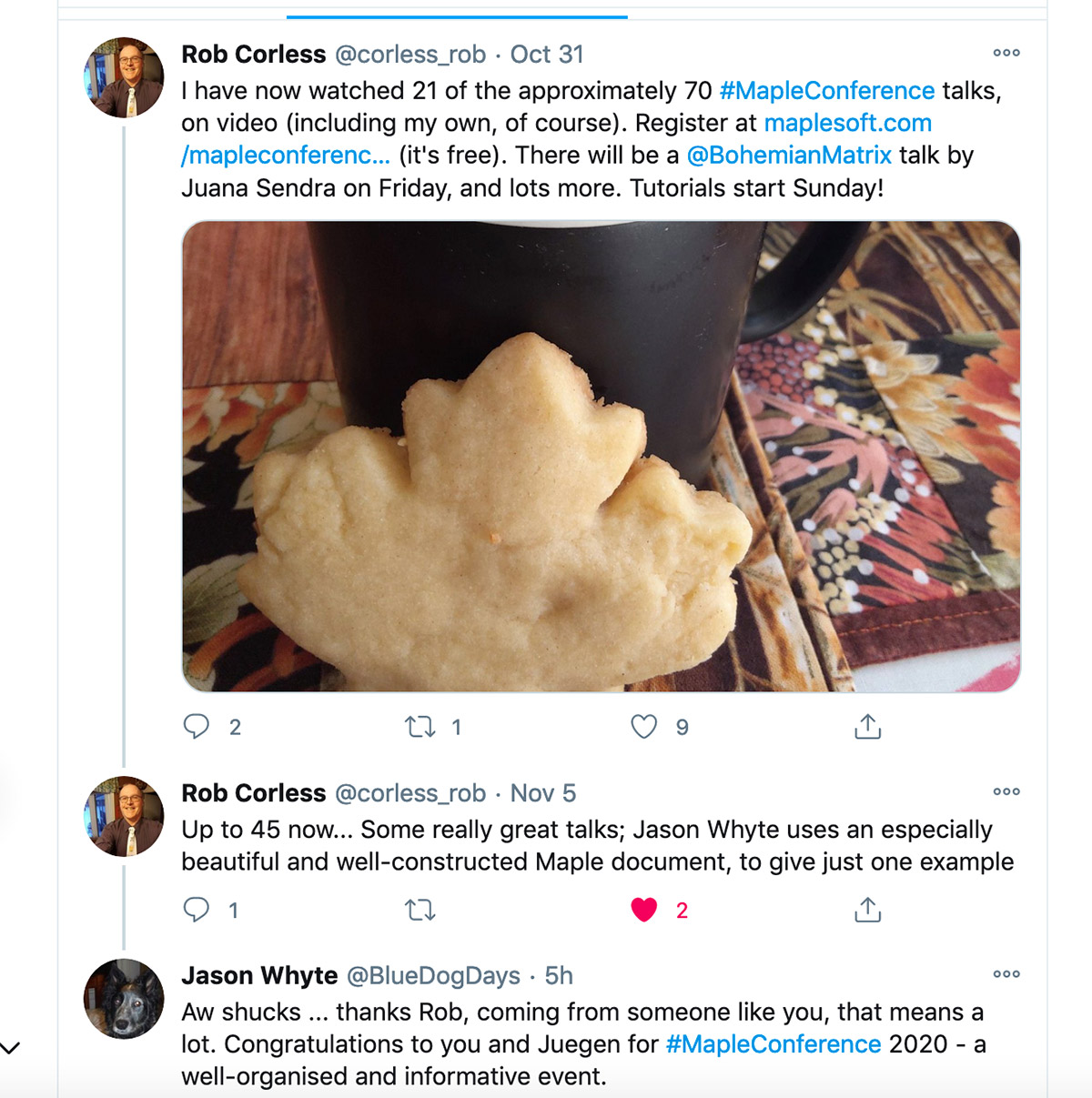
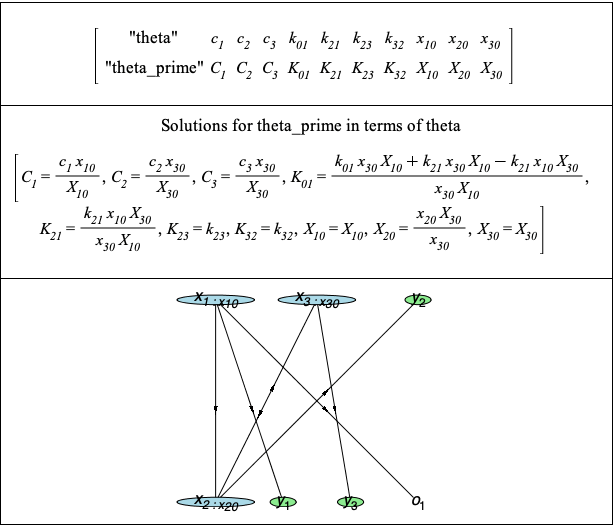
Output from the Maple dashboard used in (top) defining alternative parameters, (middle) testing an uncontrolled, "compartmental" linear time-invariant model for structural global identifiability, and (bottom) showing a compartmental diagram relating state variables, outputs, and outflows
Plans for 2021
2021 promises to be a stellar year for the Informed Decisions Theme, with a multitude of projects, collaborations and industry-relevant outputs. The following is a summary of what ACEMS researchers across Australia are planning to do. The projects include continuations of work from previous years as well as new endeavours.
General Theory:
- Make further progress in the use of operations research tools, such as Constraint Programming, logistics and optimisation, for a range of applications such as mining and warehousing.
- Research approaches for extending complex systems and Bayesian network modelling methods for inference under parameter uncertainty.
- Continue to focus on developing new methods in Bayesian design and a new grammar for experimental design.
- Develop and apply federated learning methods to allow modelling over multiple jurisdictions, without disclosing confidential or sensitive information.
- Improve methods for parameter and state estimation for queuing systems.
- Complete a new method for rapid population calibration of black-box models.
- Further pursue work into quantifying uncertainty within machine learning models to allow for informed decisions to be made in the wake of an aberrant input.
Healthy People:
- Continue to improve mathematical, statistical and machine learning models for improve the blood donation process and donor satisfaction.
- Improve methods for improved analysis of PET images, to study the activation of drugs
- Develop methods to use EEG data to identify subgroups of young people with differing mental health and cognitive function outcomes, and evaluate changes in these outcomes over time.
- Refine approaches to testing particular classes of models for structural identifiability, to better describe biochemical kinetics and possibly disease dynamics.
- Analyse electronic health record data to predict and prevent in-hospital falls.
- Use spatio-temporal models to identify spatial variation in cancer and cancer screening data across Australia, and associated risk factors, leading to improved cancer management.
- Help to manage and reduce certain types of injuries by modelling the precise spatial location of injury.
- Model malaria data in Vietnam to determine optimal intervention strategies for suppressing the disease. These results will be reported to the Vietnam National Malaria Control Program.
- Continue to collaborate with the COVID-19 Critical Care Consortium to analyse data on COVID-19 ICU patients from more than 50 countries.
- Continue to develop statistical and machine-learning methods to forecast Emergency Department presentations for long-term (up to 2050) to assist EDs to more optimally organise their resources and increase the sustainability of current health systems. Based on the success achieved throughout the study, the industry partners would like to extend the developed methodologies and applications to state and national level data.
- Develop fast algorithms for fitting Bayesian Structural Equations models to help make better sense of the data in our pre-natal alcohol project.
Sustainable Environments:
- Work with international colleagues to develop spatio-temporal models for air pollution and weather data.
- Develop methods for decision-making under uncertainty, for example predicting future water levels under a range of climate change scenarios.
- Continue to improve methods for managing and utilising novel data sources for improved environmental management and prediction.
- Work with a large consortium of researchers to develop statistical and decision science tools to safeguard the Antarctic.
Prosperous Societies:
- Work with a large inter-university team to model and analyse dogs’ behaviour under stress.
- Collaborate between nodes to develop decision pipelines for autonomous analysts in Defence.
- Develop innovative statistical models to support individualised decision making for people engaged in sport, integrating heterogeneous data of varying quantity and quality for complex, uncertain systems.
- Continue to create games that grant insight to the world of data science,
- Pursue new methods for anomaly detection to improve cybersecurity.
- Progress work on mixed integer programming problems and algorithms for industrial decision problems.
- Create methods to compare different sets of carbon pools in the SOC model and the effect of microbes in the carbon cycle process. In addition, create a new model that considers the population growth of the microbes as a dynamic process.
- Develop new methods for identifying unusual patterns of behaviour in high-dimensional electricity demand data.
